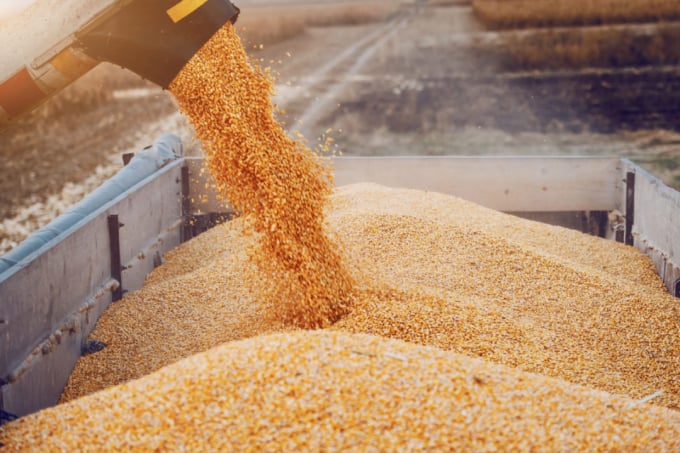June 21, 2025 | 01:24 GMT +7
June 21, 2025 | 01:24 GMT +7
Hotline: 0913.378.918
June 21, 2025 | 01:24 GMT +7
Hotline: 0913.378.918

The Russia-Ukraine conflict will affect the global corn market. Photo: TL.
According to an analysis of Agromonitor, in recent years, corn supplies from Russia and Ukraine have become more and more important in the world corn market.
Specifically, in the period 2005-2010, corn exports from Russia and Ukraine accounted for only about 6-8% of the world’s total corn revenue. However, since 2011, thanks to the expansion of growing areas and an increase in productivity, Russia, and Ukraine have accounted for nearly 20% of the world’s corn market, of which, a majority coming from Ukraine with an annual volume of 30 million tons, ranking fourth in the world, after the US, Argentina, and Brazil.
Vietnam annually imports 10-12 million tons of corn from the world market, but the amount imported from Russia and Ukraine is not significant, only accounting for an average of about 3% in the period 2016-2021.
Since October 5, 2016, Vietnam has reduced the import tax on Russian corn to 0%, making this country be much more competitive than the US and South America. As a result, Russia's corn imports to Vietnam increased sharply in 2017 but were still quite modest. Russia’s and Ukraine’s corn quality and problems related to weeds made Vietnamese enterprises not very interested in importing their products.
Although it is unpopular, a few Vietnamese enterprises had signed contracts to purchase 2 ships of Ukrainian corn before Russia attacked Ukraine to deal with a scarcity of South American corn which has resulted in high prices and a sharp price uptrend in the domestic market due to depleted inventories. The contracted purchasing price is rumored at around USD340/ton of CNF, equivalent to VND8,100 /kg which is the price at the port.
However, the Russia-Ukraine war may cause difficulties for these corn ships to leave the port in March for return to Vietnam.
With a market share of nearly 20% owned by Russia and Ukraine, the war between the two countries will have a great impact on the world corn market, thereby significantly affecting the corn market and prices of animal feed in Vietnam.
Agromonitor reported that right before the attacks which started on February 23, the world grain and energy prices kept increasing sharply until early March due to concerns about supply disruptions from the Black Sea region. There was a decrease in the prices of soybeans due to a strong uptrend of soybean oil prices. Specifically, the price of corn and wheat increased by 6%, and 12% respectively while that of dried soybean decreased by 5%, and raw soybean prices remained unchanged.
Up to the pre-conflict period, Ukraine had exported nearly 20 million tons of maize for the marketing year 2021/2022, accounting for nearly 60% of the total planned corn exports. The remaining 13.7 million tons of maize are available for exports in the coming months, equivalent to an export volume of about 2 million tons/month.
For Russia, the amount of exported corn has so far reached 2.2 million tons while about 2.3 million tons more are available for export, equivalent to one-month export of Ukraine.
As Ukraine has closed all its deep-water ports due to the conflict, countries that import the most corn from Ukraine, such as China, the EU, Egypt, and Iran, will be directly affected by a suspension of corn exports by this country. Corn prices arriving at Chinese ports increased sharply due to the possibility of supply disruptions from Ukraine. At Dalian port, the price of corn increased sharply by 70 yuan/ton (equivalent to nearly 3%) this week.
In addition to the disruption in export supplies, the damages caused by a prolonged war will result in infrastructural and human losses. An increase of immigrants to neighboring countries could also impact on cultivating of the new maize crop in Ukraine, which is expected to start in early April.
Corn supplies of the world's fourth-largest country exporter being at risk of prolonged disruption, and unforeseen damages on new-season maize production will force major importers, including China, to shift to buy more US corn or find more other supply sources. This has pushed up the price of export corn in the world market.
In another movement, with concerns about escalating tensions between Russia and Ukraine, China has allowed imports of Myanmar corn since February 18 to increase the supply of imported maize to replace Ukrainian products.
Besides, soaring oil and gas prices will put great pressure on fertilizer prices and container/ship freight charges. The export disruption in Russia and Ukraine will affect the international maritime trading chain and push up freight rates.
An increase in fertilizer prices, together with a shortage of fertilizer supply, will also directly affect the corn areas in Brazil and the US due to a sharp increase in investment costs.
In 2021, Russia was the largest fertilizer supplier to Brazil with a market share of about 22% and the second-largest fertilizer supplier to the US with a market share of about 13%. The fact that many large Russian banks are excluded from the SWIFT system may cause difficulties for export and international payment activities. Currently, the US is preparing to sow maize for the 2022/2023 crop while Brazil is also starting to plant the 2nd crop of 2022/2023, in the context that fertilizer supply from Russia faces large obstacles in payment.
Agromonitor believes that high prices of world corn and delays in signing new contracts as well as uncertainties of global corn flows could cause Vietnam's corn imports in the first half of 2022 to fall to the lowest level in the same period of the past 5 years, equivalent to a decrease of nearly 28% compared to the same period last year.
In case corn ships from Argentine are generally affected by the disruption of the global corn “flow”, causing the ships to return in April/May/June, thus being late than expected, the Vietnamese corn market will continue to heat up.
According to Agromonitor, the average corn price in 2021 increased by nearly 45% compared to that of the 2016-2020 period, equivalent to nearly VND2,000/kg.
In 2022, especially in the first 2 months of the year, the corn price continues to surge by 8-9% compared to the average level of 2021, creating great pressure on both animal feed businesses and breeders.
Translated by Linh Nguyen

(VAN) Last week, the U.S. Department of Agriculture (USDA) released its June World Agricultural Supply and Demand Estimates (WASDE), raising projections for both Indian rice production and U.S. rice imports for the 2025/2026 marketing year.
/2025/06/17/2344-1-131758_261.jpg)
(VAN) Amid tariff risks and growing trade barriers in the U.S. market, Australia is emerging as a promising destination to sustain the growth momentum of Vietnam's shrimp exports.
/2025/06/17/2013-1-nongnghiep-112009.jpg)
(VAN) This notable growth trend reflects the global taste for fresh, nutritious fruits and the expanding use of lychees across various sectors.

(VAN) The political and cultural insulation of Japan’s beloved grain is falling apart, and experts warn the country’s relationship with the staple will have to adapt.

(VAN) Noting risks, report examines impacts of avian influenza, changing trade patterns since 2022, fish fraud, and shipping industry’s net-zero goals.

(VAN) Mr. Tran Quang Bao, General Director of the Forestry and Forest Protection Department, met and worked with the International Wood Products Association to promote cooperation in the field of timber trade.

(VAN) China's outbound shipments of rare earths in May jumped 23% on the month to their highest in a year, though Beijing's export curbs on some of the critical minerals halted some overseas sales.